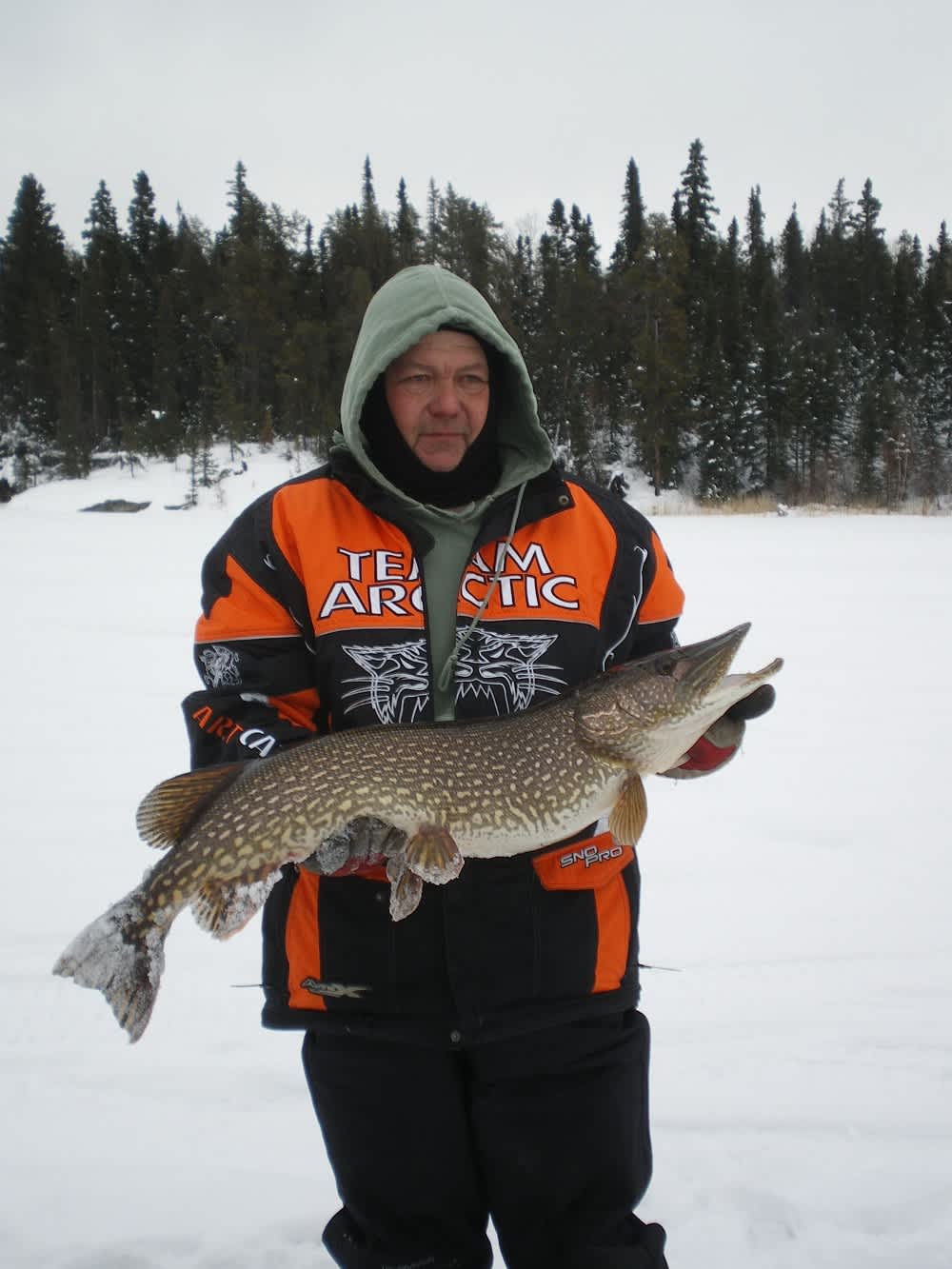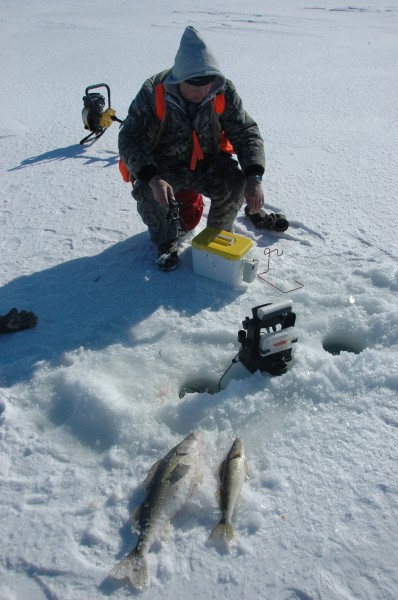Keeping the Cold on the Ice
Dan Armitage 01.23.14

“I can’t feel my feet,” Maria admitted after an hour of standing over a hole in the ice, staring at a tiny, blaze-orange bobber as if daring it to quiver.
As I approached my shivering spouse, I noticed that the florescent float was locked tight in a Saran Wrap-thin layer of skim ice that had formed across the surface of the pie-plate sized hole. Using the dipper, I broke up the ice around the bobber and strained the slush from the hole while explaining the process and how important it was to keep the hole clear.
“I would have, but my hands are colder than my feet,” she countered, “and I didn’t want to risk getting them wet. I’m freezing. Let’s go home.”
Those were the last words I wanted to hear. I had just set a half-dozen tip-ups over a weedbed that practically promised action as soon as the approaching cloud cover dimmed the bright, mid-day sunlight. And based on reports from other anglers who fished over the same reef the same time the day before, we were all but guaranteed a bucketful of first-ice walleyes for the freezer.
As a married man, I also knew better than to push the point. While we packed up the gear and retreated to the warmth of the truck for the ride home, I resolved to do some research on how to avoid the Big Chill so that our frigid experience wouldn’t be repeated.
Cold anatomy
To know how to stay warm, it’s important to understand our body’s reaction to cold. Simply put, as warm-blooded creatures, we must maintain a core body temperature in the vicinity of 98.6 degrees Fahrenheit to remain comfortable. Allowing that temperature to vary by more than a few degrees—up or down—for an extended amount of time will result in discomfort and eventually, death. Our metabolism generates the heat and we count on our blood to circulate the warmth to our extremities. When outside forces, like cold and wind and dampness, conspire to erode that heat, the first thing our body does is to reduce the flow of blood to the extremities and concentrate its warmth on more vital organs in the body core.
Insulating our body with layers of fur and fiber helps keep the heat within while blocking outside forces from whisking it away. Doing things to generate heat, like walking around, and movements to keep the blood flowing to our extremities, like wiggling our fingers and toes, is basic to keeping warm. Mere walking and wiggling won’t always cut the mustard, and there are times when additional measures must be taken to allow you to stay comfortable in cold conditions.
Avoiding cold feet
For example, we’ve learned to avoid getting cold feet while ice fishing by placing an insulating barrier between our soles and the frozen surface of the lake. We have found that we don’t even need to don cumbersome pack boots on some days—if we remember to remove the car mats from our vehicle before we head out onto the ice. By placing common car mats on the ice next to the ice-fishing hole, you can stand on them or rest your feet on them while sitting, and the rubber or rubber-and-carpet material acts as a barrier to the cold between your feet and the ice. Not only that, but standing on the car mat will help keep your feet dry when the ice surrounding the hole gets wet from the auguring, or the ice-dipping, or the fish-landing process.

If conditions are particularly frigid, a high-tech approach to foot-warming is called for. For us, that means wearing boots lined with Thinsulate, Gore-Tex, or a combination of the two space-age materials over wool socks and liner socks. If we know things are going to be downright nasty cold, and we won’t be doing much walking to help keep the blood circulating, we’ll add a pair of Grabber Toe Warmers to our footgear. The chemical heat packs are air-activated and self-adhesive; we slip the thin, crescent-shaped packets under our toes between the liner and the outer sock and can count on at least four hours of heat to keep things toasty inside our boots.
Avoiding cold fingers
Just as we are warm-blooded creatures, who must maintain our body heat at a specific temperature, fish are cold-blooded creatures, which means they have the ability to lower their body’s core temperature to match that of their surroundings. What that means to anglers is that fish don’t have to maintain a high metabolism in the winter, which means that they don’t need to eat as much or as often as they do at some other times of the year. That’s why small baits work so well in the winter; most fish don’t need as much “fuel” to stay comfortable in the cooler water.
That’s especially frustrating to winter anglers, who have to fiddle with the smallest baits, lures and hooks of the season—the same season that required them to wear gloves or mittens to protect their digits from the numbing cold! Combine that with regular exposure to the water that accompanies any active—or at least successful—ice angling and you’ve got the ingredients for frostbitten fingers.
When her fingers get cold, even when wearing her convertible mitts, Maria learned that shaking her hands, or raising and snapping them down sharply, using the same movement she does to flip water off the outside of her hands, keeps them warmer. An article she read in a medical journal recommended the practice, which actually forces warm blood down into the fingertips.
Top tip
There’s a popular saying across snow country that goes something like “To keep your feet warm, wear a hat.” Odd as it sounds, it’s true. They say that most body heat is lost through the top of the head. If you do nothing else, keep a lid on that heat and your entire body—including extremities like your ears, fingers, and feet—will stay warmer!

